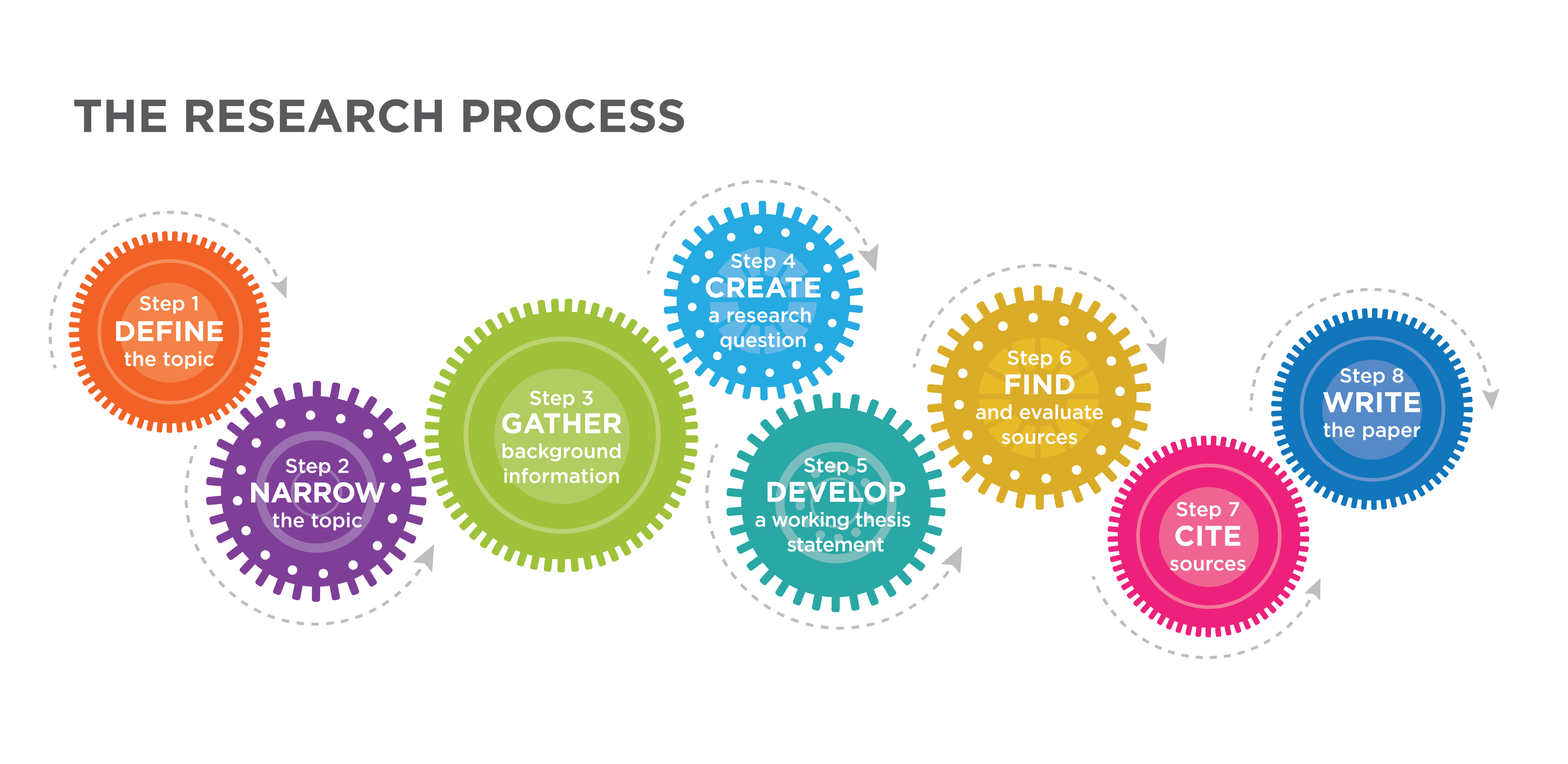The Research Process
Research is not a strict, linear process where each stage must be completed before moving on to the next. Instead, it is an iterative process—you will revisit and refine your topic, sources, and writing as you progress. Rather than waiting until you have gathered all your sources to start writing, begin early and adjust your thesis, research, and arguments as needed.
Use the following research process as a flexible guide to help you develop a well-structured and well-supported paper.

Step 1: Define the Topic
- If you have been assigned a topic, carefully review the instructions to understand its scope.
- If you can choose your own topic, select one that interests you and has enough research available.
Step 2: Narrow the Topic
Refining your topic helps focus your research and argument. Think of it like finding a seat in a stadium: you start with a general area (subject), move to a specific row (narrowed topic), and then find an exact seat (precise focus). This also helps you narrow your search parameters when you start to gather background information and sources.
- General topic: Inclusive education
- Limited topic: Neurodivergent students in a classroom setting
- Specific focus: How technology can enhance learning for neurodivergent students
Your goal is to do more than just provide a broad overview; instead, you should help facilitate your reader’s deeper understanding of the issue.
Step 3: Gather Background Information (Pre-Research)
Begin by figuring out what you know about the topic, and then fill in any gaps you may have on the basics by looking at more general sources. At this stage, Wikipedia, encyclopedias, and general web searches are useful for gathering basic information. This will help you:
- Identify key concepts and terminology related to your topic.
- Recognize common debates or areas of controversy.
- Pinpoint gaps in your understanding that need further research.
Once you understand the basics, look for areas of debate or conflicting perspectives.
Step 4: Create a Research Question
Once you have narrowed your topic so that it is manageable, it is then time to generate research questions about your topic. A strong research question:
- Is thought-provoking and sparks curiosity.
- Is open-ended (not a simple yes/no answer).
- Encourages debate and deeper exploration.
- Clearly defines what you want to investigate.
Decide which question addresses the issue that concerns you—that will be your main research question. Secondary questions will address the who, what, when, where, why, and how of the issue.
- Main research question: Do media portrayals of women highlight their strengths or weaknesses as political leaders?
- Secondary questions:
- How can more women enter leadership roles?
- What role does the media play in discouraging women from politics?
- How many women are involved in politics at the state or national level?
- Why do women leave politics, and how long do they typically stay?
Step 5: Develop a Working Thesis Statement
Once you’ve explored your research question, answer it with a working thesis statement. A thesis statement is a single sentence that identifies the topic, shows the paper’s direction, and conveys the writer’s stance. A thesis statement should:
- Narrow the subject to a single, clear argument.
- State the topic and your assertion about that topic.
- Convey the purpose of your research.
- Provide a preview of how the essay will be arranged (usually).
Step 6: Find and Cite Sources
Determine what kind of sources are best for your argument. How many sources will you need? How long should your paper be? Will you need primary or secondary sources? Where will you find the best information?
Use library databases, Google Scholar, and academic journals to find credible sources.
Step 7: Create a Bibliography While Researching
It’s a good idea to create your bibliography as you gather and reference sources in your paper, so you don’t end up scrambling to find various sources (and potentially leave some off) in the end. You can use citation management tools like Zotero, Mendeley, or EndNote to organize references.
Remember to ensure all sources are relevant, credible, and correctly cited based on your required citation style (APA, MLA, Chicago, etc.).
Step 8: Write and Edit Your Paper
Finally, you’ll incorporate the research into your own writing. Remember to:
- Start writing early and refine your work as you incorporate research.
- Properly integrate and cite your sources to support your argument.
- Revise for clarity, coherence, and logical flow.
- Proofread for grammar, punctuation, and formatting errors.
By following this process, you will develop a well-supported, thoughtfully structured paper while refining your ideas along the way.